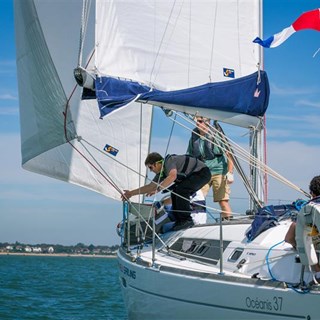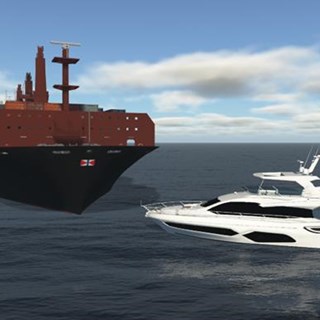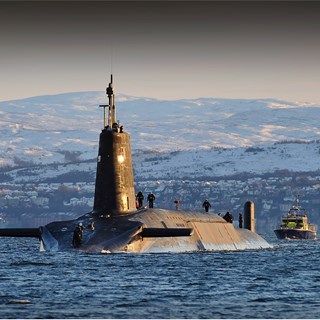
Enabling PODS: a framework for modularity
We explore the core elements of the support framework required to ensure Persistent Operational Deployable Systems (PODS) can thrive.
20 February 2025
In an increasingly uncertain future with rapidly developing technological solutions, flexibility in design and capability becomes not only a desire but an essential element to a modern naval fleet. Supported modular capabilities have the potential to provide the solution and revolutionise naval design, creating visions of future warships that can embark specialised equipment according to the mission or even reconfigure mid-deployment.
This concept has already been delivered at a small scale, notably by the Danish and US navies. However, if this approach is to be adopted across the fleet, this shift in operational capability will also require a seismic shift in the support infrastructure. In this article, we explore the core elements of the support framework required to ensure Persistent Operational Deployable Systems (PODS) can thrive, emphasising a combination of shoreside equipment/storage, onboard connectivity and a dedicated integrated logistic support set up.
There is a risk that, as these modules could fall outside the scope of the traditional vessel or equipment focused project teams, PODS could sit idle and unprepared in dockyards if left unsupported. This would prevent the rapid deployment for which they were originally designed. To reach their full potential, modules will need to be held securely in a state of continuous readiness, waiting to be deployed at a moment’s notice.
By addressing critical elements such as safety, cyber security, integration with host platforms, and compliance with standards, we can ensure that PODS not only meet operational needs but are also adaptable and secure for future uses across defence.
A structured yet flexible framework approach is proposed to ensure that identified challenges are met, enabling successful PODS procurement, deployment, operations, and support. The establishment of an Overall PODS Authority (OPA) is recommended to provide cohesive management, enhancing the integration, reliability, and effectiveness of PODS in achieving operational objectives.
In a world of rapid innovation but fixed budgets, we face a significant challenge: either accept a net capability loss or change our approach. The traditional focus of ship design has been on fixed platforms with fixed capabilities, but to overcome the challenges we face today, we need to transition to an adaptable and protean force.
There are three core challenges that flexible capabilities aim to address. Firstly, budget limitations present a significant hurdle; with constrained budgets and increasingly expensive systems and equipment, resources must be managed judiciously. Secondly, crewing restrictions hamper our ability to acquire the right number of personnel with the necessary skills. Finally, maintenance challenges arise from the drive for greater availability, coupled with fewer hull numbers, making effective maintenance increasingly important; how can we support more effective shore-based maintenance whilst allowing the main vessel to operate at sea?
To maintain technological advantage a novel approach is needed embracing flexible capability without undermining the balance and effectiveness of the wider vessel. We must also understand where a traditional organic ship-fit is the right answer and not make a ship’s capability flexible for the sake of it.
It is important to outline that PODS, although a powerful option, are not the only answer for flexible capability insertion. There should be an open discussion around the trade-off between modularity - which is designed to be switched out on a regular basis and have a switch-out period of several hours - compared to adaptable spaces which are more space-effective and cost-effective but require weeks of outfit time to re-configure. We need to consider the period a capability will be based on the vessel; if it is likely to be there for 10 years then an adaptable solution will be more cost-effective and arguably more capable than a modularised solution. If the capability will only be needed for a few months, then a modular solution with the additional structure and infrastructure is a better solution.
With modules, there is a growing portfolio of designs and resources. Existing applications include command and control, accommodation, weapon systems, logistics, medical, and uncrewed systems operations to name a few. However, when looking to the future we should not be constrained by previous thinking or only think about what we can put in a module; instead, we should treat it as a blank canvas and ask what capability will be needed and how to get the module to work. Are we restricting our thinking to standard TEU containers, or is there scope for innovation in delivering modularity without restricting ourselves to a box?
To shift adoption from smaller scale operations into a true protean force, a seismic shift in support infrastructure is required:
Shoreside support infrastructure
A key feature of adopting modular systems is the ability to support equipment ashore rather than in-situ. This has significant technical cost benefits, including allowing equipment to be returned to the manufacturers for maintenance, where they can be in controlled environments and enable ease of access. Benefits in flexibility and increased availability can be achieved if modules can be rotated to different ships with equipment deployed where needed. This does create the need for a robust logistics chain to be established; modules must be removed from ships, transported to warehousing and maintenance facilities, stored and maintained in readiness whilst awaiting delivery to a ship. Use of standardised modules sizes such as the TEU aids the logistical chain as they can be transported using existing infrastructure but for deployed vessels there is a need to recognise if these modules can be securely transported over distance, possibly through several countries, and securely stored overseas if required. There will also be cost involved, particularly if the logistics chain is to be secured and “ready to use when needed.”
Onboard vessel support infrastructure
As well as onshore support arrangements, there must be standardisation and consistency to the onboard integration. When considering the connection to the vessel the immediate considerations are power connections and access, but the full requirements are far more diverse. Integration with the host platform Combat System, including weapons, requires careful planning for suitable network interface controllers using Fibre Optics (FO) or copper connections. To ensure POD versatility there will be a need to consider internal electronics and multi I/O connectors for various functionalities such as EOD, RADAR, antenna, and weapon systems. Cooling requirements for RADAR, communications, and weapon systems must be met. Structurally, PODS must, as a minimum conform to ISO standards for lifting and anchoring, while maintaining internal modularity. The POD must remain within weight limits driven by or designed into the ship where they are located. Cybersecurity is another pivotal aspect for vessel integration; Adopting a "Secure by Design" (SbD) approach, as advocated by Defence Digital, is essential to managing cyber risks effectively throughout the lifecycle of the capability and ensuring that Defence information and digital systems are secure.
Support framework
Procuring PODS involves several additional risks and issues that must be managed to ensure cross-defence efficacy. There is a risk that if this separate capability is not given fixed ownership, then capability improvement could fall between the gaps of the different platform and equipment teams. There is no point in investing in a modular capability if the module you need is not available at the time you need it. We propose the creation of a dedicated support team with a collaborative framework to ensure the maximum availability of all modules, planning their deployment storage, maintenance, and upgrades.
Many drivers indicate the need to explore more flexible platforms. Modularity provides a key role in enabling flexible platforms but needs to be utilised alongside adaptable and enduring capabilities designed into the ship. The intended operation of the ship needs to be considered from the outset when integrating flexibility to support the operation of the ship not just be an additional feature.
The transition to a modular approach with PODS necessitates a robust and well-coordinated support framework. The integration of shoreside and onboard vessel support infrastructures, combined with a dedicated logistic setup, is essential for the success of this innovative operational capability. Although modular capabilities provide a flexible solution, a system of systems approach is still required; the supporting vessel is not just a “platform” to hold the capability but a core component of the warfighting capability. We need to ensure a holistic approach to design, including the modules.
For this vision to become a reality, we need to act now. We need to invest in, and support, the development of these systems, considering the implications for Defence Lines of Development (DLOD) and exploring the necessary ecosystem modelling to enhance capability within the industry.
We will present our full paper on this topic at Combined Naval Event 2025 in Farnborough, 20-22 May.

Jake Rigby is Head of Innovation & Research, responsible for the portfolio management of internal research projects. This covers a broad range of topics from ship and submarine design to digital twins and artificial intelligence. Through this role he leads the horizon scanning activities of BMT, tracking external trends and developing the reactive technology roadmaps. He is always on the lookout for the next emerging technology that can revolutionise or incrementally change the way we and our customers operate. He is a chartered engineer and member of the Royal Institute of Naval Architects, originally training as a Naval Architect before his current research role. Jake is also responsible for Academic Engagement at BMT. In recognition of his work to progress Academic Engagement in the maritime sector he was awarded the title of Honorary Associate Professor at the University of Exeter, and continues to engage in a range of collaborative research projects.

Tim Curtis
Most transformation programmes fail—not because of poor execution, but because they never truly understood the race they were competing in. The BMT Strategy Canvas changes that.

Kathryn Walker
Coaching is a proven tool to support change leaders and their teams. The greatest impact and success has been achieved in transformation programmes, where structural and programmatic approaches are supported by attention to the cultural and behavioural aspects of change.

Will Roberts
At BMT, we believe simulation is a critical enabler in overcoming these hurdles—de-risking development, accelerating innovation, and building confidence across the entire lifecycle of autonomous systems.

N/A
Imagine gaining more space, deeper dives, faster refits, and safer missions—all by moving one critical system outside the pressure hull. Discover how pressure-tolerant lithium-sulphur batteries are transforming submarine design, and why this breakthrough isn’t just theoretical—it’s ready for deployment. Whether you're upgrading or designing new, this is capability you can deliver today.